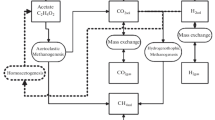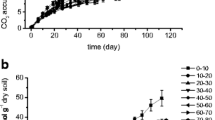Abstract
The potential methane consumption activity was examined in various plant communities of a boreal Sphagnum-dominated Bakchar bog of West Siberia. In aerobic laboratory incubations, the peat consumed methane with the maximal rates varied from 17 to 153 nmol CH4 h−1g− 1.The highest oxidation took place in the peat from the cotton grass and dwarf shrub-cotton grass communities. The addition of different N-compounds inhibited CH4-uptake and was not a simple influence of shift in ionic balance (`salt effect'). The introduction of sodium chloride resulted in significantly weaker inhibition effect than the same amount of nitrite and nitrate salts. The inhibition occurred at NH4 +-N concentrations exceeding 100 mg kg−1, which was more than 200 times higher native N-content in peat. Communities with high CH4-uptake activity were more sensitive to ammonium. The inhibition by ammonium was non-competitive. The inhibition by ammonium was mainly due to the toxic action of nitrite and/or nitrate produced by nitrifiers. A strong positive correlation was found between the potential nitrifying activity and inhibition of CH4-uptake in ammonium-treated peat (R 2= 0.87). The oxidized N-compounds were more strong inhibitors than ammonium and their toxicity increased in the following range: NH4 +< NO2 −< NO3 −.
Similar content being viewed by others
References
Adamsen A P S and King G M 1993 CH4 consumption in temperate and subarctic forest soils: Rates, vertical zonation and responses to water and nitrogen. Appl. Environ. Microbiol. 59, 485-490.
Bodelier P L E, Roslev P, Henckel T and Frenzel P 2000 Stimulation by ammonium-based fertilizers of methane-oxidation in soil around rice roots. Nature 403, 421-424.
Boeckx P and O Van Cleemput 1996 Methane oxidation in a neutral landfill cover soil: Influence of moisture content, temperature, and nitrogen-turnover. J. Environ. Qual. 25, 178-183.
Castro M S, Steudler P A, Melillo J M and Aber J D 1995 Factors controlling atmospheric methane consumption by temperate soils. Global Biogeochem Cycles 9, 1-10.
Crill P M, Martikainen P J, Nykanen H and Silvola J 1994 Temperature and N fertilization effects on methane oxidation in a drained peatland soil. Soil Biol. Biochem. 26, 1331-1339.
Gorham E 1991 Northern peatlands: role in the carbon cycle and probable responses to climatic warming. Ecol. Appl. 1, 182-195.
King J M and Schnell S 1998 Effects of ammonium and nonamonium salts additions on methane oxidation by Methylosinus trichosporium OB3b and maine forest soils. Appl. Environ. Microbiol. 64, 253-257.
Kravchenko I K and Tokareva E V 1999 Influence of nitrogen compounds on methane oxidation in omrotrophic bog, Tver region. In The Mires and Raised Bogs in Relation on Rational Use of Natural Resourses. Eds. Vompersky S E and Sirin A A. pp 201-204. GEOS, Moscow, Russia (in Russian)
Krumholz L R, Hollenback J L, Roskes S J and Ringelberg D B 1995 Methanogenesis and methanotrophy within a Sphagnum peatland. FEMS Microbiol. Ecol. 18, 215-224.
Megraw S R and Knowles R 1987 Active methanotrophs suppress nitrification in a humisol. Biol. Fertil. Soils. 4, 205-212.
Mosier A R, Schimel D, Valentine D, Bronson K and Parton W 1991 Methane and nitrous oxide fluxes in native, fertilized and cultivated grasslands. Nature 350, 330-332.
Panikov N S, Sizova M V, Zelenev V V, Makhov G A, Naumov A V and Gadziev I M 1995 Emission of CH4 and CO2 from swamps of West Siberia: Spatial and temporal variation of fluxes. Ecol. Chem. 4, 13-24.
Panikov N S, Glagolev M V, Kravchenko I K, Mastepanov M A, Kosych N P, Mironycheva-Tokareva N P, Naumov A V, Inoue G and Maxutov S 1997 Variability of methane emission fromWest-Siberian wetlands as related to vegetation type. Ecol. Chem. 6, 59-67.
Reeburg W S, Whalen S C and Alperin M J 1993 The role of methylotrophy in the global CH4 budget. In Microbial Growth on C-1 Components. Eds. J C Murrell and D P Kelly. pp 1-14. Intercept.
Steudler P A, Bowden R D, Melillo J M and Aber J D 1989 Influence of nitrogen fertilization on methane uptake in temperate forest soils. Nature 341, 314-316.
Whalen S C 2000 Influence of N and non-N salts on atmospheric methane oxidation by upland boreal forest and tundra soils. Biol. Fertil. Soils. 31, 279-287.
Author information
Authors and Affiliations
Rights and permissions
About this article
Cite this article
Kravchenko, I.K. Methane oxidation in boreal peat soils treated with various nitrogen compounds. Plant and Soil 242, 157–162 (2002). https://doi.org/10.1023/A:1019614613381
Issue Date:
DOI: https://doi.org/10.1023/A:1019614613381




